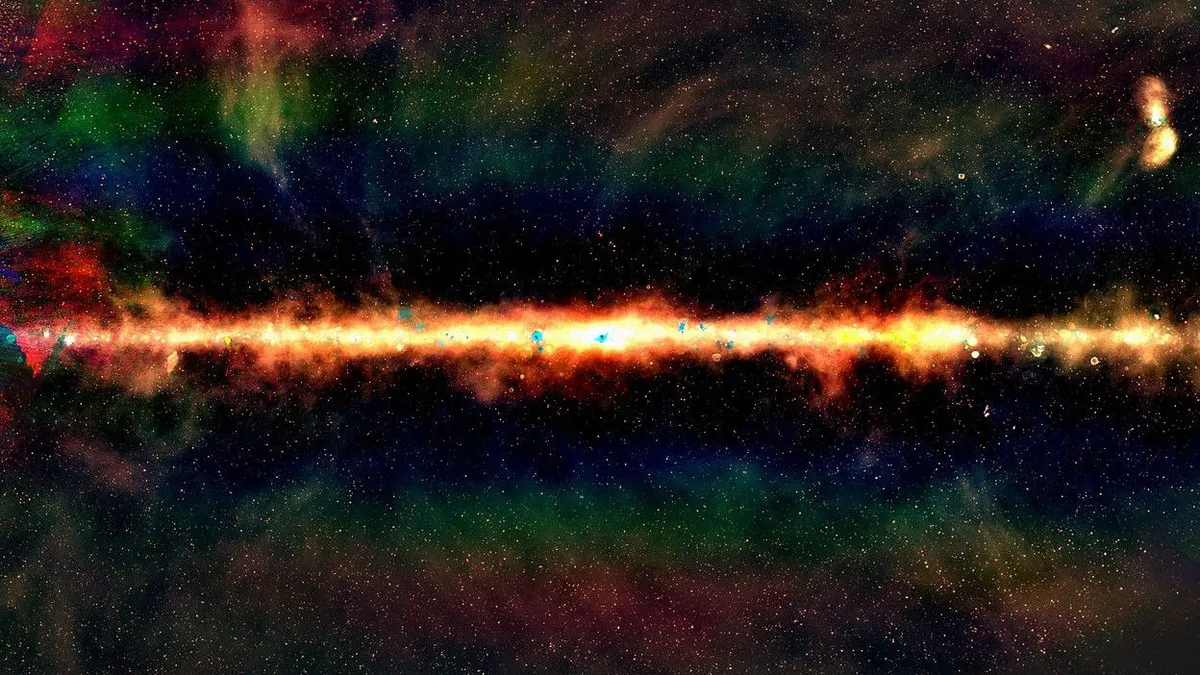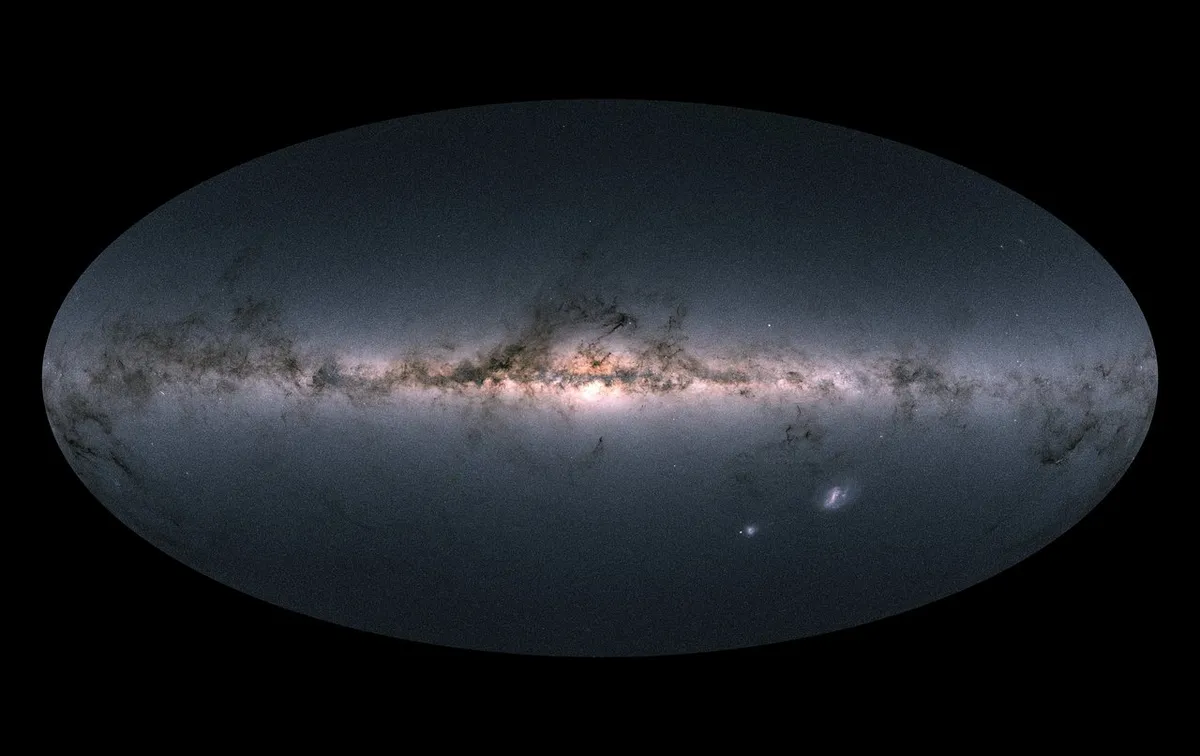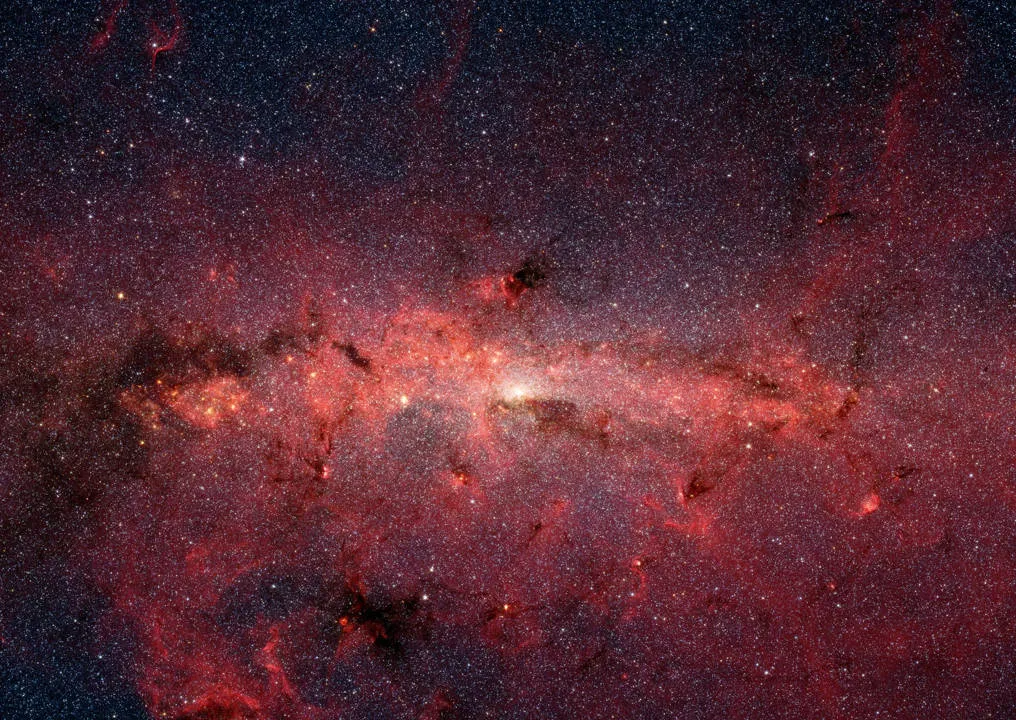The Milky Way galaxy is much too big for us to be able to send a spacecraft far enough into space that it could turn around, photograph our Galaxy and show us what it really looks like.
The Andromeda Galaxy is the nearest major galaxy to the Milky Way, and it's about 2.5 million lightyears away.
So reaching a distance where we could capture an image of our own galaxy similar to those we see of the Milky is not currently physically possible.

If you were sitting in the living room of a house, with solid walls around you, would you be able to tell what the rest of the house looked like?
This is the problem faced by astronomers trying to map out what our Galaxy looks like while sitting on a planet within it.
Buried inside its disc, all they can see is a few local stars before gas and dust shroudsthe view, blocking the light from the Milky Way’s distant reaches.
Yet despite this they have managed to not only map out our local neighbourhood, they can see right across town thanks to the largest survey of our Galaxy to date by ESA’s Gaia satellite.

What shape is the Milky Way?
To start such cosmic cartography the first question that needs answering is the morphology – the form, shape and structure – of the Galaxy we live in.
We know from looking at our celestial neighbours that galaxies can be elliptical, spiral, irregular or dwarf, but what is the Milky Way like?
You can answer that query yourself the next time you’re under a dark sky looking at our view through the Galaxy – the Milky Way.
With the naked eye it just looks like a diffuse cloud of light, but through a telescope it resolves into a band made from billions of stars.

The Milky Way is our view through a huge plane of stars, showing we are sitting within a huge stellar disc.
"From looking at other galaxies we know that most discs show some spiral structure," says galactic astronomer Prof Robert Benjamin from University of Wisconsin-Whitewater.
"Because the Galaxy is a disc galaxy it is almost certainly a spiral galaxy."
These other spiral galaxies show arms of stars and dust wrapped around a central bulge of old stars, so it was thought likely that the Milky Way was the same.

How do we know what shape the Milky Way is?
Proving the shape of the Milky Way has not been an easy task.
The best way to find our Galaxy’s spiral structure was to map out the location of the arms.
Dense with dust, the arms are prime sites for stars to form, and are alive with bright, young O and B class
stars.
In 1958 astronomer William Morgan used these youthful stars to trace out the Milky Way’s structure close to Earth.
Beyond around 10,000 lightyears, the haze of dust throughout our Galaxy became too thick, blocking out the light from stars behind it and bringing the mapping effort to a halt.
It was only when Jan Oort led the first large-scale radio survey a year later that the a map of the whole Galaxy could be drafted.

This project, Benjamin explains, mapped hydrogen gas between the stars using the 21cm spectral line it produces.
"That line can be seen across the entire Milky Way because the radio penetrates the gas," he adds.
As hydrogen is a vital ingredient in creating new stars, where the regions where the gas was thickest dictated where a spiral arm should be.
The surveys showed that the structure was definitely present in the Milky Way, but what was less clear was where the arms actually lay.
Though determining the direction of a clump of gas is easy, working out how far away it is proved difficult.
For these radio observations, the distance was determined using the Galaxy’s rotation.

Determining the Milky Way's rotational speed
Different parts of the Milky Way disc move with different speeds depending on how far out from the centre they
are.
When objects are moving fast enough the light they emit gets stretched out, changing its frequency, an effect known as Doppler shift.
This size of this stretch can be used to find the object’s speed, which provides an estimate the distance.
However, this method is notoriously uncertain. There’s no way to tell if an object is moving at a certain speed because it’s far away, or because random fluctuations mean it happens to be moving a bit faster.
The result is measurements have an error margin of more than 20%.
Despite these flaws, the radio surveys began to reveal the general shape of the Milky Way.

Finding the centre of the Milky Way
As well as the arms, the surveys found that stars were densest in the direction of Sagittarius, suggesting this was the direction of the Galaxy’s central bulge.
The exact centre was thought to lie in the middle of a complex radio source 25,000 to 28,000 lightyears from the Sun.
This was confirmed in 1974 when it was found to host a supermassive black hole, one of which is known to lie in the cores of many galaxies.

Another layer of this central region was peeled back by the infrared COBE satellite.
Mapping the entire sky between 1989 and 1993, COBE revealed an asymmetry in the gas of the Milky Way’s core.
This was the first hint that the Milky Way was not only a spiral galaxy, but a barred spiral.
An elongated bar of stars extends through the centre of the Milky Way, at an angle of 27º from the Sun, with the two major arms spinning off from either end.

The Galaxy gets in the way
Beyond this busy central region things begin to get a bit less defined, as the problems caused by the Galaxy getting in the way of itself only intensify.
"The area of greatest uncertainty is anything that’s the other side of the galactic centre, but inside the Sun’s orbit," says Benjamin.
"Anything within the Sun’s orbit is very hard to measure with Doppler shift because it gets confused with stuff that’s closer and that happens to be going at the same velocity.
The main structures are identified. But exactly how to place them is still debated."
A type of star found in areas of high star formation, known as a maser, emits clear radio waves that can penetrate through the entire Milky Way.
In recent years, a team has been using the Very Long Baseline Array to find the distances to these masers by recording their parallaxes – measurements calculated directly from geometry, making them much more accurate than those found via the Doppler method.

Another satellite is currently in the process of taking the parallaxes of not just a handful of bright stellar objects but over one billion stars, around 1% of the Milky Way’s stellar content.
Gaia’s map of the Milky Way is the most accurate map of the Galaxy we have.
The emerging atlas charts not only the stellar layout within the disc, but also the globular clusters and stars that orbit high above the Milky Way’s disc.
"There are stars that move outside the plane, but are dominated by masses within the plane," says Benjamin.
"If you know the velocity of a star, you can usually work backwards to find out where the mass is, so kinematics [the study of movement] outside the disc will tell you a lot about what’s going on inside the disc."
It’s these stars that have helped mark out the limits of our Galaxy.
Spotted 50,000 lightyears away from the galactic centre they denote where the arms of the Milky Way, and our map, come to an end.

Does the Milky Way have 2 arms or 4?
The uncertainties and huge error margins caused by mapping the Milky Way from within can often lead to controversy over their interpretation.
One of the biggest debates in recent years has been over how many arms our Galaxy has: two or four.
"If you were an alien in a galaxy far, far away, you would see four arms, because the arms that you see at visible wavelengths are really just showing the very bright blue stars near areas of star formation," says research astronomer Ronald Drimmel from the Italian National Institute for Astrophysics.
"The real question is if you looked at the old stars, where most of the mass is. That would be a two-armed spiral."

The two most massive arms of the Galaxy – Perseus and Scutum-Centarus – have many of these older stars, and their strong gravitational pull causes gas and dust to pile up between them.
Two lesser arms, called Sagittarius-Carina and the Outer arm, don’t have as many elderly stars to make up the mass, but are rich enough in gas to be bright with star formation.
To confuse matters further, there are also many bridges and spurs jutting off the major arms.
One of these – the Orion spur, originating in the Sagittarius arm and crossing the Perseus arm – is particularly relevant to us here on Earth; it’s the location of our Sun and Earth in the Milky Way.
However, data from the NASA Spitzer Space Telescope was used to infer that our Milky Way Galaxy actually has two arms, not four, and that is now generally agreed upon.
This article appeared in the November 2016 issue of BBC Sky at Night Magazine

